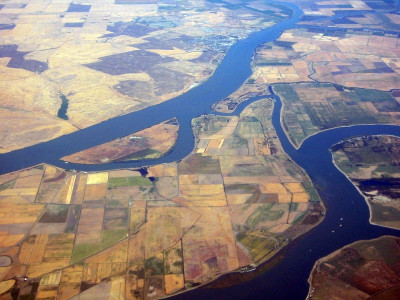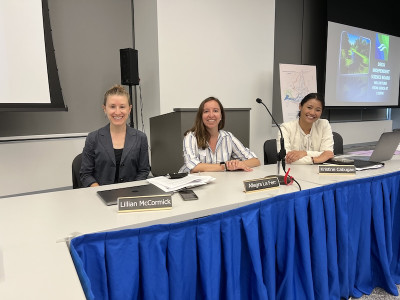Considering how important it would end up being for her emerging career, Kristine Cabugao is embarrassed that she had never heard of the Delta Independent Science Board before applying for a postdoctoral position there. “I’m even from California,” says Cabugao. However, as a trained soil ecologist— with an interdisciplinary Ph.D. in energy science and engineering from the University of Tennessee, Knoxville — her focus had been firmly on terrestrial issues. When an informational interview introduced her to the Delta ISB, Cabugao jumped at the chance to branch out into the aquatic world.
The California Delta — technically the Sacramento-San Joaquin Delta — is the West Coast’s largest estuary, with a good 1,100 square miles of open water and agriculture, dotted with towns and cities. Managed by the Delta Stewardship Council, a state agency, the region provides drinking water for two-thirds of Californians and important habitats for many of the state’s commercial fisheries such as Chinook salmon and sturgeon.
As a scientific oversight board supporting the Stewardship Council, the Delta ISB periodically reviews management practices in the Delta. By combining the perspectives of broadly a dozen experts in freshwater and marine ecosystems, the Board creates an outside reference for federal and state agencies, non-profits, water agencies and the broader science community working in the Delta. Recently, the Delta Stewardship Council created two Delta ISB postdoc positions with support from California Sea Grant.
Exploring Carbon Markets

Cabugao’s work for the Delta ISB incorporated her soil expertise but also took her out of her scientific comfort zone. She contributed to a review that focused on subsidence, a longtime issue in the region. As farmers started to drain water from the Delta’s peaty ground in the late 1800s, the soil became exposed to oxygen and began decomposing. “Microbes are digesting the organic matter and effectively this means that the Delta is sinking,” says Cabugao. In some places, the ground now sits up to 25 feet below sea level, putting it at risk for flooding, particularly as sea levels rise. “It’s a thorny problem,” says Cabugao.
Cabugao, who did some work for the Climate Change Science Institute at Oak Ridge National Laboratory in Tennessee as a graduate student, was familiar with the process of subsidence. “But a key question is, what do we do about it?” she asks. The Delta ISB postdoc position appealed to her as it offered an opportunity to engage directly with stakeholders on such environmental issues, bridging the gap between scientific research and public policy. “It's an experience you don’t usually get within academic training,” she says. “You are either in the lab or in the field to do your testing, then you publish.”
As a Delta ISB postdoc, Cabugao reviewed the scientific literature on soil subsidence, summarized its findings and briefed the Board. Then she assembled a list of people affected by or interested in the topic — including regulators, farmers, community members and scientific and academic communities — and helped set up a two-day workshop to bring them together.
The meeting of the minds brought some important insights. For example, carbon markets have been floated as a financial incentive to reduce soil subsidence. The idea is, in a nutshell, that farmers who turn their fields into wetlands or rice paddies to stop subsidence receive carbon credits that they can then sell to offset lost income. “It is thought to be a win-win,” says Cabugao.
However, some farmers at the workshop were skeptical. They pointed out a problem that outsiders tend to overlook: To obtain carbon credits, farmers often need to sign contracts that commit them to keeping carbon in the soil for 40 years, whereas the rest of their business typically operates on much shorter time frames that rarely exceed five years. These diverging timelines can make it hard for farmers to join in. “There’s some work here that needs doing,” says Cabugao.
Probing Deep Uncertainty

She also contributed to a second review, about how to prepare for deeply uncertain threats to the Delta such as flooding compounded by an earthquake. And she studied what could be done to avoid negative environmental impacts of a major infrastructure proposal, called the Delta Conveyance Project. The project aims to build a massive underground tunnel to move water from the Sacramento River to southern parts of California.
Cabugao's postdoc experience did more than broaden her professional skills — it catapulted her career in an unexpected direction. "I wanted to go beyond soil microbiology and hoped to expand my knowledge with this position, but never in my wildest dreams would I have imagined that I would, for example, gain social science skills such as finding themes in interviews and reports," she reflects.
The unique training made for a smooth transition into Cabugao's current role as a Community and Climate Resiliency Manager at The Nature Conservancy in Missouri. "Now, I provide support for issues like water quality and drought resilience, and I stepped into the role already knowing how to communicate science to non-science audiences," Cabugao says. "This postdoc was the only one I encountered that offered this kind of opportunity. It fills a crucial gap between scientific research and practical application."
About California Sea Grant
NOAA’s California Sea Grant College Program funds marine research, education and outreach throughout California. Headquartered at Scripps Institution of Oceanography at the University of California San Diego, California Sea Grant is one of 34 Sea Grant programs in the National Oceanic and Atmospheric Administration (NOAA), U.S. Department of Commerce.